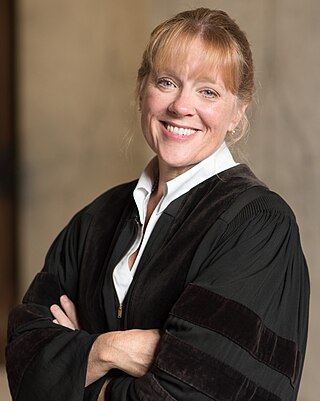Related Research Articles

The United States courts of appeals are the intermediate appellate courts of the United States federal judiciary. The courts of appeals are divided into 13 "Circuits". Eleven of the circuits are numbered "First" through "Eleventh" and cover geographic areas of the United States and hear appeals from the U.S. district courts within their borders. The District of Columbia Circuit covers only Washington, DC. The Federal Circuit hears appeals from federal courts across the United States in cases involving certain specialized areas of law. The courts of appeals also hear appeals from some administrative agency decisions and rulemaking, with by far the largest share of these cases heard by the D.C. Circuit. Appeals from decisions of the courts of appeals can be taken to the U.S. Supreme Court.
The Supreme Court of the State of New York is the trial-level court of general jurisdiction in the New York State Unified Court System. It is vested with unlimited civil and criminal jurisdiction, although in many counties outside New York City it acts primarily as a court of civil jurisdiction, with most criminal matters handled in County Court.
The government of the U.S. state of Ohio consists of the executive, judicial, and legislative branches. Its basic structure is set forth in the Constitution and law of Ohio.

The Supreme Court of Maryland is the highest court of the U.S. state of Maryland. The court, which is composed of one chief justice and six associate justices, meets in the Robert C. Murphy Courts of Appeal Building in the state capital, Annapolis. The term of the Court begins the second Monday of September. The Court is unique among American courts in that the justices wear red robes.

The government of Maryland is conducted according to the Maryland Constitution. The United States is a federation; consequently, the government of Maryland, like the other 49 state governments, has exclusive authority over matters that lie entirely within the state's borders, except as limited by the Constitution of the United States.

The federal judiciary of the United States is one of the three branches of the federal government of the United States organized under the United States Constitution and laws of the federal government. The U.S. federal judiciary consists primarily of the U.S. Supreme Court, the U.S. Courts of Appeals, and the U.S. District Courts. It also includes a variety of other lesser federal tribunals.

The Supreme Court of Texas is the court of last resort for civil matters in the U.S. state of Texas. A different court, the Texas Court of Criminal Appeals, is the court of last resort in criminal matters.
The Superior Court is the state court in the U.S. state of New Jersey, with statewide trial and appellate jurisdiction. The New Jersey Constitution of 1947 establishes the power of the New Jersey courts. Under the State Constitution, "'judicial power shall be vested in a Supreme Court, a Superior Court, County Courts and inferior courts of limited jurisdiction.'" The Superior Court has three divisions: the Appellate Division is essentially an intermediate appellate court while the Law and Chancery Divisions function as trial courts. The State Constitution renders the New Jersey Superior Court, Appellate Division the intermediate appellate court, and "[a]ppeals may be taken to the Appellate Division of the Superior Court from the law and chancery divisions of the Superior Court and in such other causes as may be provided by law." Each division is in turn divided into various parts. "The trial divisions of the Superior Court are the principal trial courts of New Jersey. They are located within the State's various judicial geographic units, called 'vicinages,' R. 1:33-2(a), and are organized into two basic divisions: the Chancery Division and the Law Division".

The Ohio Seventh District Court of Appeals is one of the twelve Ohio District Courts of Appeal, the state intermediate appellate courts of Ohio. It has jurisdiction over eight counties: Belmont, Carroll, Columbiana, Harrison, Jefferson, Mahoning, Monroe, and Noble.
The Ohio District Courts of Appeals are the intermediate appellate courts of the U.S. state of Ohio. The Ohio Constitution provides for courts of appeals that have jurisdiction to review final appealable orders. There are twelve appellate districts, each consisting of at least one county, and the number of judges in each district varies from four to twelve. Each case is heard by a three-judge panel. There are currently 69 courts of appeals judges as provided by statute. A court of appeals judge is an elected position, with a term of six years. The Ohio Supreme Court has the discretion to review cases from the courts of appeals, but generally the appeals process in Ohio ends with the decision of the court of appeals.
The Illinois Appellate Court is the court of first appeal for civil and criminal cases rising in the Illinois Circuit Courts. Three Illinois Appellate Court judges hear each case and the concurrence of two is necessary to render a decision. The Illinois Appellate Court will render its opinion in writing, in the form of a published opinion or an unpublished order. As of 1935, decisions of the Illinois Appellate Court became binding authority upon lower courts in Illinois.

The Florida circuit courts are state courts and trial courts of original jurisdiction for most controversies. In Florida, the circuit courts are one of four types of courts created by the Florida Constitution.
The Georgia Court of Appeals is the intermediate-level appellate court for the U.S. state of Georgia.
The West Virginia Circuit Courts are the West Virginia state trial courts of general jurisdiction. They are the only state trial courts in West Virginia that are courts of record. West Virginia's 55 counties are divided into 31 circuits, each comprising anywhere from one to four counties. Different circuits have different numbers of judges; 11 circuits have only a single judge. Effective with the 2024 election, the circuits will be realigned into 30 circuits, with only one having a single judge.
Robert Alexander Nader was an American Democratic politician who served as a city councilman, state representative and judge in Ohio.
The Judiciary of California or the Judicial Branch of California is defined under the California Constitution as holding the judicial power of the state of California which is vested in the Supreme Court, the Courts of Appeal and the Superior Courts. The judiciary has a hierarchical structure with the California Supreme Court at the top, California Courts of Appeal as the primary appellate courts, and the California Superior Courts as the primary trial courts.

Colleen Mary O'Toole is an American politician who presently serves as Prosecutor for Ashtabula County, Ohio. O'Toole previously served as an Appellate Judge of the Ohio Eleventh District Court of Appeals. O'Toole was first elected in 2004 to the Court of Appeals in 2004. O'Toole left the Eleventh District at the end of her term in February 2011 after being defeated in the 2010 election, and founded award-winning, On Demand Interpretation Services, LLC, an entrepreneurial start up that provides certified interpretation in 170 languages and American sign-language to public entities and their support networks. In 2012, she returned to the Eleventh District Court of Appeals by defeating sitting Judge Mary Jane Trapp. O'Toole was defeated in her bid for re-election in 2018 when she lost in the Republican primary to Matt Lynch. In 2020, O'Toole was elected Prosecutor for Ashtabula County, Ohio, flipping the office to the Republicans.
The judiciary of Michigan is defined under the Michigan Constitution, law, and regulations as part of the Government of Michigan. The court system consists of the Michigan Supreme Court, the Michigan Court of Appeals as the intermediate appellate court, the circuit courts and district courts as the two primary trial courts, and several administrative courts and specialized courts. The Supreme Court administers all the courts. The Michigan Supreme Court consists of seven members who are elected on non-partisan ballots for staggered eight-year terms, while state appellate court judges are elected to terms of six years and vacancies are filled by an appointment by the governor, and circuit court and district court judges are elected to terms of six years.
Justin Brett Busby is a current Justice of the Supreme Court of Texas and a former justice of the 14th Court of Appeals of Texas whose six-year term ended December 31, 2018. Along with many other Republican incumbents on the State's largest intermediate appellate courts, Busby was narrowly defeated in the November 2018 Democratic sweep.
References
- ↑ www.11thcourt.co.trumbull.oh.us
- ↑ Ohio Revised Code 2501.01
- ↑ Ohio Revised Code 2501.012, 2502.02
- ↑ Ohio Revised Code 2105.02
- ↑ "Eleventh District Court of Appeals". www.co.trumbull.oh.us/11thcourt. Retrieved 2023-10-23.
- ↑ Ohio Revised Code 2501.012(D)
- ↑ "Ohio Eleventh District Court of Appeals - Ballotpedia". www.ballotpedia.org. Retrieved 2023-10-23.